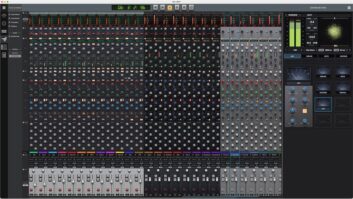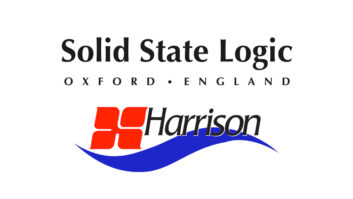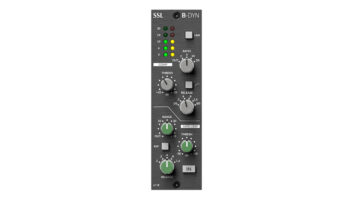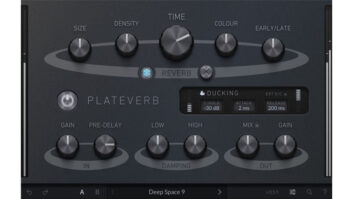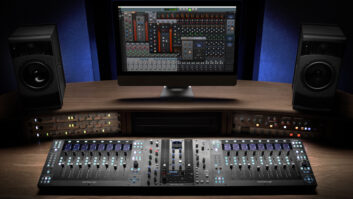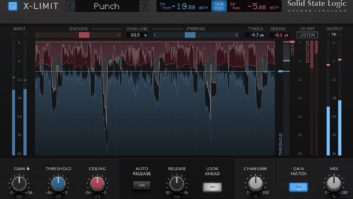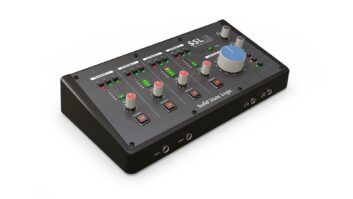
In the past couple of years, manufacturers such as Solid State Logic (SSL) and Neve have recognized the pent-up demand in mid-level markets for the sound of their large-format consoles and, as such, have issued affordable modules that incorporate those boards’ key features. The SSL XLogic X-Rack — reviewed in the September 2006 issue of Mix — is but one example of this growing trend.
Now, SSL is at it again with its XLogic Alpha Channel, a 1RU channel strip that mates a preamp based on the company’s Duality console with a soft-clip limiter, 3-band equalizer and other goodies — all at an affordable $1,995 list.
CHANNEL SURFING
An XLR/TRS combo jack located on the front panel accepts balanced mic or line, or unbalanced instrument input. This input feeds the VHD™ (Variable Harmonic Drive) preamp, which is key to Alpha Channel’s glorious sound. The pre’s continuously variable, rotary input gain control provides 20 to 76 dB of gain for mic/line input and 26 to 82 dB of gain for instrument input. High signal levels — whether caused by a hot input signal or by cranking the input gain control for quieter signals — cause the preamp’s VHD circuit to add harmonic distortion to the signal; lower signal levels don’t excite the VHD circuitry, which allows for a more pristine sound. Whereas the company’s Duality console and E Signature channel strips provide a switch for turning VHD circuitry on and off, VHD is always in circuit in Alpha Channel.
A continuously variable, rotary VHD control adds second-harmonic distortion (similar to what tube circuits produce) to the audio path when it is set fully counterclockwise. As the knob is turned clockwise, the distortion increases and becomes progressively dominated by third-harmonic distortion, producing the trashy sound of transistors overloading when the knob is at full-clockwise position.
Four push-button switches also serve the VHD preamp section. An input impedance switch provides low impedance for mic input and high impedance for instrument or line-level input. A pad switch provides 20dB attenuation; SSL recommends its use on line-level input signals, but I often broke that rule, as you’ll soon read. Switches for 48-volt phantom power and polarity inversion are also provided.
Following the VHD preamp section are three switches that govern the use of balanced, ¼-inch TRS insert send and return jacks located on the rear panel. One switch puts the inserts in or out of circuit, another places the unit’s 3-band EQ pre/post-inserts, and the third switch sums the send signal with the return signal for applications such as parallel compression. In addition to patching the inserts to external processors, you can use the insert send as a headphone feed before DAW input to avoid monitoring latency. You can also route a prerecorded track to the insert return to access Alpha Channel’s equalizer cleanly while bypassing the VHD section.
PUSH MY BUTTONS
Two push-button switches act in combination to kick in a highpass filter and set its corner frequency to 40, 80 or 120 Hz. Another switch activates the equalizer section, which offers three overlapping bands. The low-frequency band can be switched to provide either shelving or bell-curve response (the latter with a fixed Q of 1.4), while the mid-frequency band is fully parametric (including a rotary Q control) and the high-frequency band is shelving type. Each of the bands provides separate, continuously variable frequency and boost/cut controls, with the latter offering detents at unity gain. Depending on the band, a maximum boost/cut of 15 to 19 dB is afforded.
A continuously variable, rotary, output gain control follows the EQ section. It provides ±20 dB of gain adjustment and a 0dB detent. The output gain feeds a defeatable soft-clip limiter dubbed Lite Limit.
All of Alpha Channel’s push-button switches light up when activated. Additionally, the pad switch glows red to indicate when the VHD pre overloads (often a good thing!), and the Lite Limit switch’s backlighting changes from green (active status) to orange to red as levels feeding the limiter get hotter.
A six-segment LED meter on the front panel shows the output level before the Alpha Channel’s built-in A/D. Digital output is via an S/PDIF connector on the rear panel. A main analog output is also provided on a balanced ¼-inch TRS jack. The S/PDIF output’s left channel delivers the same signal as the main analog output, while its right channel yields the pre-insert send signal.
The S/PDIF output will synchronize to an external clock signal at its S/PDIF input, accepting sampling rates from 32 to 192 kHz. When no external S/PDIF signal is provided, the A/D converter free-runs at a fixed 44.1kHz rate. An LED lights on Alpha Channel’s front panel to indicate that its A/D has locked with an external clock. SSL chose S/PDIF synchronization in lieu of providing a word clock input to keep Alpha Channel’s list price down. In addition to the previously mentioned insert jacks, the rear panel also offers RCA jacks — wired in parallel — to daisy-chain the limiters of multiple Alpha Channels.
SUBSTANCE ABUSE
My first test of Alpha Channel was on a Strat plugged directly into the unit’s instrument input. I got nice, clean tones with low input gain and the VHD control set counterclockwise. Then I started to intentionally abuse the unit. I cranked the input gain to overdrive the pre, set the VHD knob clockwise for transistor-style distortion and drove the Lite Limit hard to make it saturate and pump. The guitar sounded incredible, brimming with colorful and full-bodied overtones and warm sustain.
Miking up a guitar cabinet with the backside of a Royer R-122 and routed to Alpha Channel’s mic input (with phase flipped), I got a wide variety of tones — all of them absolutely superb — by using various I/O gain and VHD settings with and without Lite Limit. Patching Alpha Channel’s inserts to my Universal Audio LA-2A and summing send and return signals created a parallel compression scheme that yielded the perfect blend of density and nuance.
Next, I routed a pre-recorded kick drum track to Alpha Channel’s line input. I left the input-impedance switch in low position (1 kilohm) to soften the top end and left the pad switch out to overdrive the VHD circuit while lowering the input and output gain controls to compensate for the drastic input levels. With the VHD knob set to about 11:30 o’clock for a blend of second- and third-harmonic distortion, and Lite Limit switched in (and smashed) to round off the peaks, the sound was absolutely phenomenal. The kick’s attack was now brighter and tighter, and had the perfect balance of meat and thwack.
Using similar settings to process pre-recorded electric bass added grit and overtones that made it sound much richer. I also got superb results processing pre-recorded snare drum, this time with Lite Limit bypassed and high-input impedance selected. Adding a little Waves TransX processing and gated reverb created an awesome gunshot snare.
On miked acoustic guitar, I got the cleanest sound by boosting Alpha Channel’s output close to max and using only as much input gain as was needed to hit 0 dBFS. Alpha Channel delivered open, detailed recordings of both acoustic guitar and male vocals. But clearly, the unit’s calling is dishing out rippin’ drums, bass and electric guitar tracks.
THE FINAL ANALYSIS
In an A/B test, my Apogee Rosetta offered a little more depth than Alpha Channel’s high-quality A/D. Unfortunately, the latter’s external synchronization via S/PDIF input may require you to sacrifice an entire DAW I/O bank for each Alpha Channel used (unless the unit’s main analog outputs are employed). And while I found the quality of Alpha Channel’s EQ to be on par with that of other midpriced channel strips, the omission of markings for intermediate frequency-knob settings often made deliberate tonal sculpting tedious and difficult. In fact, all of the unit’s rotary controls have titling for only minimum and maximum settings, and SSL’s cursory owner’s manual and Website offer no additional documentation to help here.
Despite these shortcomings, Alpha Channel is a big winner sonically. For positively huge drum, bass and electric guitar tracks that shout “hit record,” this box delivers in spades.
Solid State Logic, 212/315-1111, www.solid-state-logic.com.
Mix contributing editor Michael Cooper is the owner of Michael Cooper Recording in Sisters, Ore. Visit him online at
www.myspace.com/michaelcooperrecording.
